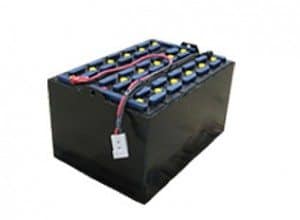Types of forklift batteries – Different batteries explained
Understanding Different Types of Forklift Batteries
Let’s explore the types of forklift batteries commonly used in warehouses today.
Information and History of a Forklift Battery
Invented in 1859 by French physicist Gaston Planté, the lead-acid battery was the first battery technology put to commercial use. Lead-acid batteries remain the leading source of stored energy for forklifts, golf carts, wheelchairs, and automobiles, thanks to their reliability and relatively low cost.
Charging a Forklift Battery
Lead-acid forklift batteries are slow to recharge and must be stored in a fully charged state. Charging is required every 30 days to avoid sulfation, which can impair the battery’s ability to be recharged.
Preventing Damage to a Forklift Battery
Avoid deep-cycling a battery, as deep discharges strain the battery and shorten its lifespan. Many forklifts will prevent over-discharge by indicating 0% charge when the battery is actually at 20%.
Life Expectancy of a Forklift Battery
Forklift lead-acid batteries typically have a work life of 1,500 cycles or more. Maintaining proper charging and watering records is essential to collect on manufacturer warranties. Battery companies can conduct a destructive cell analysis to identify issues such as grid corrosion and sediment build-up. Proper record-keeping can improve your negotiating position when it’s time for battery replacement.
How Heavy is a Forklift Battery?
Lead-acid batteries have low energy density but provide important ballast weight. For example, a 3,000 lbs capacity reach truck requires at least 1,900 lbs of ballast for safe operation. The battery not only powers the forklift but also plays a crucial role in counterbalancing loads.
Plate Thickness and Ballast Weight
Battery weight can indicate its service life. A thicker positive plate contains more active material, which increases durability. Ask your battery supplier for the weight of their batteries to compare their value and life expectancy. Forklift batteries typically have plates over 1/4” (6mm) thick, and most industrial flooded deep-cycle batteries use lead-antimony plates that improve plate life but increase water loss.
Sealed Lead-Acid Forklift Batteries
Maintenance-free batteries, often used in controlled environments like pharmaceutical manufacturing, are sealed and can operate in any position. These batteries have gelled acid and valve-regulated caps for venting during charging. However, moisture loss can shorten their lifespan. Manufacturers recommend keeping the battery’s charge between 40% and 80% to extend its life.
Temperature of a Forklift Battery
The optimal operating temperature for lead-acid batteries is 25°C (77°F). Higher temperatures reduce battery life. For every 8°C (15°F) increase in temperature, battery life is cut in half. A battery that lasts 10 years at 25°C may only last five years at 33°C (95°F), and as little as one year in desert temperatures of 42°C (107°F).
Absorbed Glass Mat (AGM) Batteries for Forklifts
AGM batteries, commonly used in high-performance cars, are known for their durability and resistance to shock and vibration. While AGM batteries are sealed and maintenance-free, they are nearly twice the cost of flooded lead-acid batteries. They use absorbed glass mats to recombine oxygen and hydrogen inside the cells, minimizing water loss.
Pros and Cons of Lead-Acid Forklift Batteries
Pros
- Inexpensive and simple to manufacture.
- Mature, reliable, and well-understood technology – durable when used correctly.
- Low self-discharge compared to other rechargeable batteries.
- Capable of high discharge rates.
Cons
- Low energy density – poor weight-to-energy ratio limits their use to wheeled and stationary applications.
- Cannot be stored in a discharged condition – cell voltage should never drop below 2.10V.
- Limited number of full discharge cycles – best suited for standby applications with occasional deep discharges.
- Lead content and electrolyte make the battery environmentally unfriendly.
- Transportation restrictions on flooded lead-acid batteries due to spillage risks.
- Thermal runaway can occur if improperly charged.
For more information on various battery technologies, please visit: http://batteryuniversity.com
Please log in to leave a comment.



No Comments Yet